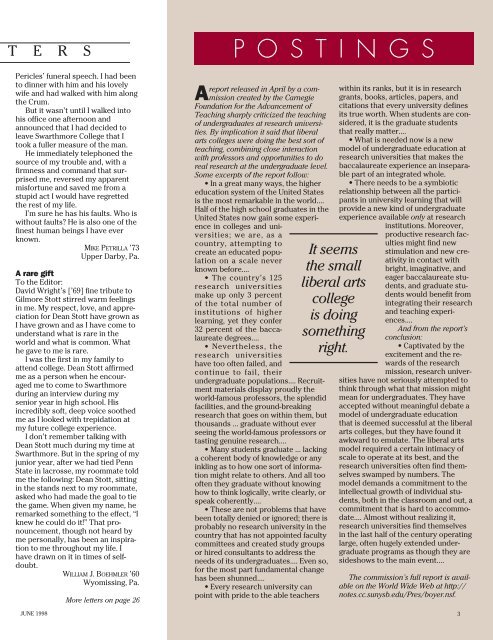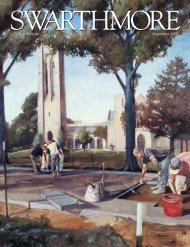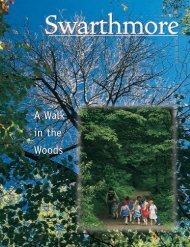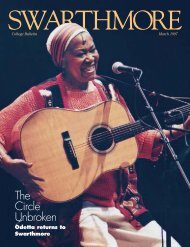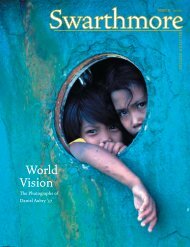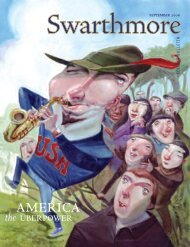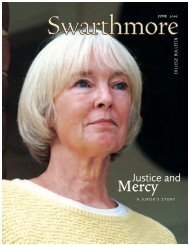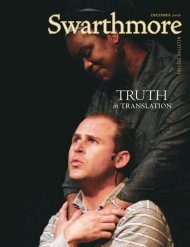Swarthmore College Bulletin (June 1998) - ITS
Swarthmore College Bulletin (June 1998) - ITS
Swarthmore College Bulletin (June 1998) - ITS
- No tags were found...
Create successful ePaper yourself
Turn your PDF publications into a flip-book with our unique Google optimized e-Paper software.
T E R SPericles’ funeral speech. I had beento dinner with him and his lovelywife and had walked with him alongthe Crum.But it wasn’t until I walked intohis office one afternoon andannounced that I had decided toleave <strong>Swarthmore</strong> <strong>College</strong> that Itook a fuller measure of the man.He immediately telephoned thesource of my trouble and, with afirmness and command that surprisedme, reversed my apparentmisfortune and saved me from astupid act I would have regrettedthe rest of my life.I’m sure he has his faults. Who iswithout faults? He is also one of thefinest human beings I have everknown.MIKE PETRILLA ’73Upper Darby, Pa.A rare giftTo the Editor:David Wright’s [’69] fine tribute toGilmore Stott stirred warm feelingsin me. My respect, love, and appreciationfor Dean Stott have grown asI have grown and as I have come tounderstand what is rare in theworld and what is common. Whathe gave to me is rare.I was the first in my family toattend college. Dean Stott affirmedme as a person when he encouragedme to come to <strong>Swarthmore</strong>during an interview during mysenior year in high school. Hisincredibly soft, deep voice soothedme as I looked with trepidation atmy future college experience.I don’t remember talking withDean Stott much during my time at<strong>Swarthmore</strong>. But in the spring of myjunior year, after we had tied PennState in lacrosse, my roommate toldme the following: Dean Stott, sittingin the stands next to my roommate,asked who had made the goal to tiethe game. When given my name, heremarked something to the effect, “Iknew he could do it!” That pronouncement,though not heard byme personally, has been an inspirationto me throughout my life. Ihave drawn on it in times of selfdoubt.WILLIAM J. BOEHMLER ’60Wyomissing, Pa.JUNE <strong>1998</strong>More letters on page 26P O S T I N G SAreport released in April by a commissioncreated by the CarnegieFoundation for the Advancement ofTeaching sharply criticized the teachingof undergraduates at research universities.By implication it said that liberalarts colleges were doing the best sort ofteaching, combining close interactionwith professors and opportunities to doreal research at the undergraduate level.Some excerpts of the report follow:• In a great many ways, the highereducation system of the United Statesis the most remarkable in the world....Half of the high school graduates in theUnited States now gain some experiencein colleges and universities;we are, as acountry, attempting tocreate an educated populationon a scale neverknown before....• The country’s 125research universitiesmake up only 3 percentof the total number ofinstitutions of higherlearning, yet they confer32 percent of the baccalaureatedegrees....• Nevertheless, theresearch universitieshave too often failed, andcontinue to fail, theirundergraduate populations.... Recruitmentmaterials display proudly theworld-famous professors, the splendidfacilities, and the ground-breakingresearch that goes on within them, butthousands ... graduate without everseeing the world-famous professors ortasting genuine research....• Many students graduate ... lackinga coherent body of knowledge or anyinkling as to how one sort of informationmight relate to others. And all toooften they graduate without knowinghow to think logically, write clearly, orspeak coherently....• These are not problems that havebeen totally denied or ignored; there isprobably no research university in thecountry that has not appointed facultycommittees and created study groupsor hired consultants to address theneeds of its undergraduates.... Even so,for the most part fundamental changehas been shunned....• Every research university canpoint with pride to the able teachersIt seemsthe smallliberal artscollegeis doingsomethingright.within its ranks, but it is in researchgrants, books, articles, papers, andcitations that every university definesits true worth. When students are considered,it is the graduate studentsthat really matter....• What is needed now is a newmodel of undergraduate education atresearch universities that makes thebaccalaureate experience an inseparablepart of an integrated whole.• There needs to be a symbioticrelationship between all the participantsin university learning that willprovide a new kind of undergraduateexperience available only at researchinstitutions. Moreover,productive research facultiesmight find newstimulation and new creativityin contact withbright, imaginative, andeager baccalaureate students,and graduate studentswould benefit fromintegrating their researchand teaching experiences....And from the report’sconclusion:• Captivated by theexcitement and the rewardsof the researchmission, research universitieshave not seriously attempted tothink through what that mission mightmean for undergraduates. They haveaccepted without meaningful debate amodel of undergraduate educationthat is deemed successful at the liberalarts colleges, but they have found itawkward to emulate. The liberal artsmodel required a certain intimacy ofscale to operate at its best, and theresearch universities often find themselvesswamped by numbers. Themodel demands a commitment to theintellectual growth of individual students,both in the classroom and out, acommitment that is hard to accommodate....Almost without realizing it,research universities find themselvesin the last half of the century operatinglarge, often hugely extended undergraduateprograms as though they aresideshows to the main event....The commission’s full report is availableon the World Wide Web at http://notes.cc.sunysb.edu/Pres/boyer.nsf.3


